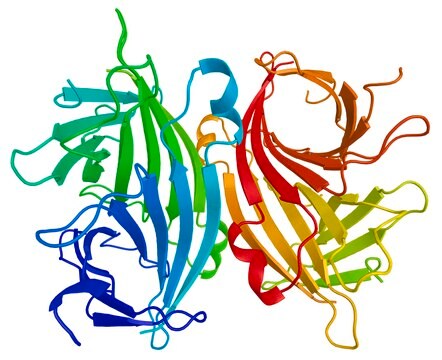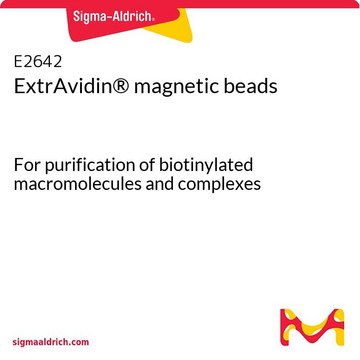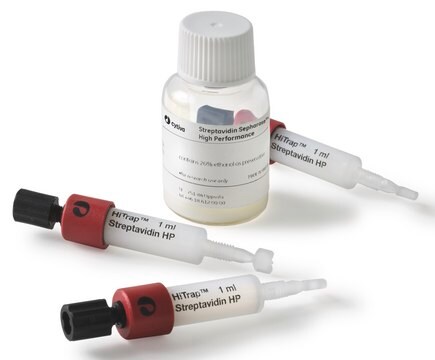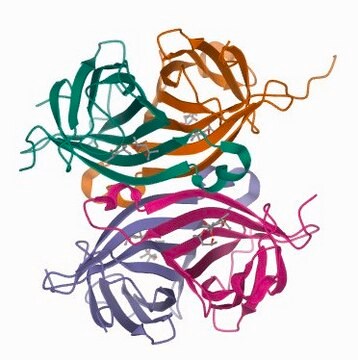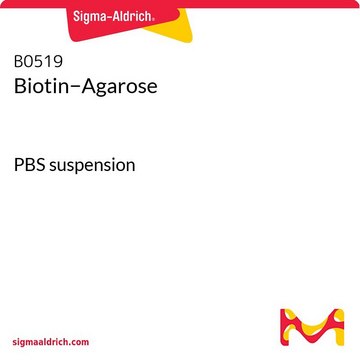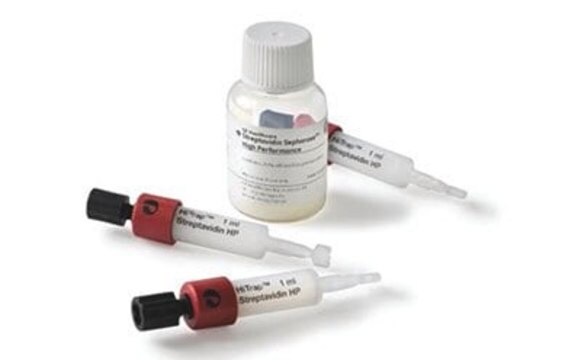E2513
ExtrAvidin®-Agarose, high binding
For purification of biotinylated macromolecules and complexes
Synonym(s):
ExtrAvidin® beads, de-glycosylated Avidin
Sign Into View Organizational & Contract Pricing
All Photos(1)
About This Item
UNSPSC Code:
41106500
NACRES:
NA.56
Recommended Products
form
aqueous suspension
suspension
feature
For purification of biotinylated macromolecules and complexes
concentration
50%
matrix
4% agarose (beaded)
matrix activation
cyanogen bromide
storage temp.
2-8°C
General description
ExtrAvidin® is a unique de-glycosylated Avidin modified form of an affinity purified egg white avidin. The ExtrAvidin is conjugated to cyanogen bromide-activated agarose beads.
ExtrAvidin® is a tetrameric protein containing four biotin binding sites. The Avidin-Biotin high affinity interaction (Kd=10-15M) is considered one of the strongest non-covalent interactions known in nature. The use of Avidin-Biotin complex for affinity purification was described in the first half of 1970 and since then it was successfully utilized in numerous studies and biotechnological applications.1-3 This was achieved due to the ability to chemically coupe the small Biotin molecule with different binders, without disturbing its function or structure, thus allowing unique interaction with a variety of Avidin carriers including: protein or DNA molecules, Avidin protein bound to a solid surface matrix, reporter molecules, probes or carriers,. Among the known Avidin-Biotin interaction based applications are purification, enrichment, detection, amplification and other research medical and industrial processes. In addition, the ExtrAvidin® high specificity binding to Biotin, together with the low background staining, grant it significant advantage compared to the non-modified Avidin or Streptavidin produced by Streptomyces avidinii.
ExtrAvidin® is a tetrameric protein containing four biotin binding sites. The Avidin-Biotin high affinity interaction (Kd=10-15M) is considered one of the strongest non-covalent interactions known in nature. The use of Avidin-Biotin complex for affinity purification was described in the first half of 1970 and since then it was successfully utilized in numerous studies and biotechnological applications.1-3 This was achieved due to the ability to chemically coupe the small Biotin molecule with different binders, without disturbing its function or structure, thus allowing unique interaction with a variety of Avidin carriers including: protein or DNA molecules, Avidin protein bound to a solid surface matrix, reporter molecules, probes or carriers,. Among the known Avidin-Biotin interaction based applications are purification, enrichment, detection, amplification and other research medical and industrial processes. In addition, the ExtrAvidin® high specificity binding to Biotin, together with the low background staining, grant it significant advantage compared to the non-modified Avidin or Streptavidin produced by Streptomyces avidinii.
Application
ExtrAvidin®-Agarose provides high affinity with high specificity binding to Biotin (also known as vitamin B7) including biotinylated proteins and biotin-tagged fusion proteins. The product may be used in various immunological techniques, including Immunoprecipitation and Immunoaffinity purification.
Caution
DO NOT FREEZE
Physical form
ExtrAvidin®-Agarose is provided as suspension at a 1:1 ratio, in 0.01 M phosphate buffered saline, pH 7.4, containing 15 mM sodium azide as a preservative.
Legal Information
ExtrAvidin is a registered trademark of Merck KGaA, Darmstadt, Germany
Disclaimer
This product is for research use only, not for drug, household, or other uses. Please consult the Material Safety Data Sheet for information regarding hazards and safe handling practices.
Storage Class Code
10 - Combustible liquids
WGK
WGK 3
Flash Point(F)
Not applicable
Flash Point(C)
Not applicable
Choose from one of the most recent versions:
Certificates of Analysis (COA)
Lot/Batch Number
Don't see the Right Version?
If you require a particular version, you can look up a specific certificate by the Lot or Batch number.
Already Own This Product?
Find documentation for the products that you have recently purchased in the Document Library.
Customers Also Viewed
Samantha Ames et al.
Oncogene, 39(8), 1710-1723 (2019-11-15)
Tumor cells rely on glycolysis to meet their elevated demand for energy. Thereby they produce significant amounts of lactate and protons, which are exported via monocarboxylate transporters (MCTs), supporting the formation of an acidic microenvironment. The present study demonstrates that
Our team of scientists has experience in all areas of research including Life Science, Material Science, Chemical Synthesis, Chromatography, Analytical and many others.
Contact Technical Service

